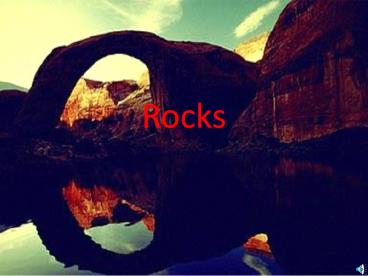Rocks - PowerPoint PPT Presentation
1 / 17
Title:
Rocks
Description:
Rocks The Rock Cycle Interactions between water, air and land can cause rocks to change from one form to another. This process is called the ROCK CYCLE. – PowerPoint PPT presentation
Number of Views:99
Avg rating:3.0/5.0
Title: Rocks
1
Rocks
2
The Rock Cycle
Interactions between water, air and land can
cause rocks to change from one form to another.
This process is called the ROCK CYCLE.
3
The Rock Cycle the basics
- Rocks are broken into small pieces (sediment)
- Sediment gets cemented together (makes different
rocks) - Rocks get subjected to a lot of heat and pressure
(makes different rocks) - Magma and lava cool (makes different rocks)
4
Types of RocksRocks any naturally occuring
solid mass of mineral or mineral-like material
5
Sedimentary RocksHow They are Made
- Wind and water break down the earth
- Bits of earth settle in lakes and rivers
- Layers are formed and build up
- Pressure and time turn the layers to rock
6
Types of Sedimentary Rocks
7
Sedimentary Rock Formation
- Weathering breaks rock into sediments
- Erosion weathering combined with movement of
rock sediment (Water, wind, ice, gravity) - Deposition process of sediment being moved by
an element of erosion to another place - Compaction sediments are squeezed together
- Cementation dissolved minerals fill in the
spaces between sediments
8
Sedimentary Rock Classification
- Clastic made from weathered bits of rock and
grouped according to the size of sediments in the
rock EX. Shale and Breccia - Chemical made from dissolved minerals falling
out of solution. This usually happens when water
evaporates. EX. Limestone and Rock Salt
9
Metamorphic RocksWhat are They?
- Rocks that have changed
- They were once igneous or sedimentary
- Pressure and heat changed the rocks
10
Types of Metamorphic Rocks
11
Metamorphic Rock Formation
- Occurs when temperature and pressure are high in
the Earths surface and mantle - Contact Metamorphism magma intrudes into
existing rock, changes in the rock occur where
the magma touches the existing rock - Regional Metamorphism mountain building large
scale changes - Agents of Metamorphism heat, pressure, reaction
to water
12
Metamorphic Rocks Classification
- Foliated layered looking. These layers have
different densities EX. Shale - Non-foliated no layers or bands. Usually have
only one mineral EX. Marble
13
Igneous RocksWhat are They?
- Fire Rocks
- Formed underground by trapped, cooled magma
- Formed above ground when volcanoes erupt and
magma cools
14
Types of Igneous Rocks
15
Classification Igneous Rocks
- Intrusive made beneath the Earths surface
(from magma) - Extrusive made above the Earths surface (from
lava) - REMEMBER magma and lava are the same thing.
Except we call magma lave when it reaches the
Earths Surface
16
Classification Igneous Rocks - cont
- Course-grained texture large crystals, slow
cooling - Fine-grained texture small crystals, fast
cooling - Glassy texture little to no crystals, crazy fast
cooling - Porphyritic texture large and small crystals
due to cooling that occurs over thousands of
years
17
Igneous Rock Composition
- Granitic makes up continental crust
- Basaltic makes up the ocean floor
- These rocks are made of different concentrations
of materials like silicate. - Granitic - high silicate concentration.
- Basaltic - low silicate concentration.
- These differences effect rock density. Rock
density determines how plates of rock move.
Important for when we talk about Plate Tectonics.





























